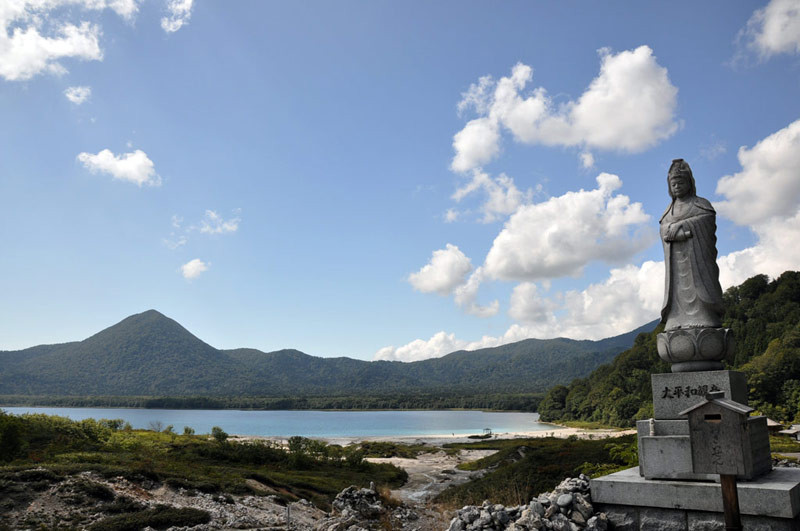Shimokita Peninsula
Scary Mountains & Buddha's Coast
The Shimokita Peninsula (Shimokita Hantō) forms the northernmost extension of Japan’s main island of Honshū. On the tip of the peninsula, the town of Ōma offers clear views across the Tsugaré Strait all the way to Hokkaido.
Much of this sparsely-populated peninsula is part of the Shimokita Hantō Quasi-National Park, dotted at intervals with wind-power generating stations quietly spinning their 34-m (112-ft) blades in the wind.
The town of Sai on the western coast of the peninsula is the doorway to Hotoké-ga-ura, a remarkable 3-km (1.9 mile) stretch of coastline with 100-m (328 ft) high sail-like rock extrusions that have been carved into remarkable shapes by the wind and waves, bright white forms contrasting against the green cliffs of the coast. ‘Hotoké-ga-ura’ is believed to be a corruption of the Ainu word ‘Hotoké-uta,’ meaning ‘coast of the Buddhas,’ as the unique formations are said to resemble Buddha images. Tour boats leave Sai Port roughly once an hour between 9:00 a.m. and 3:00 p.m., the round-trip taking about an hour.
Osoré-zan (literally, ‘Mount Fear’) is one of the three holiest places in Japan—the other two being Hiei-zan in Shiga and Koya-san in Wakayama. According to legend, in the 9th century the Buddhist priest En’nin had a dream instructing him to walk from Kyoto until he found a precisely-described sacred mountain. Once there, he was to carve a statue of Jizo, the guardian deity of lost children. The long-suffering priest didn’t find the right location until he arrived at Osoré-zan.
Osoré-zan Bodai Temple (Osoré-zan Bodai-ji) rests on a bleak landscape of steaming sulfur and pitted stone the color of bleached bones, surrounded by eight mountain peaks representing the eight petals of a lotus flower, the symbol of the world of Buddha. The interior valley, called Jigoku-dani (‘Valley of Hell’) holds 108 boiling ponds that represent the 108 worldly desires and the hells linked to each, while the surrounding vista of verdant mountains, gleaming sands, and deep blue waters in Lake Usori represents paradise beyond.
Osoré-zan is considered not only holy, but haunted. The area adjacent to the temple is filled with Buddhist sculptures and cairns built up from small chalky stones, each stone representing a lost child.
Unlike Shinto shrines, where visitors clap twice to summon deities for good luck, visitors to Osoré-zan clap only once to specifically avoid summoning the ghosts. Further, while it is traditional to offer a five-yen coin while praying at a shrine, at Osoré-zan, any coin without a ‘five’ in its denomination is best. The Japanese for ‘five yen,’ ‘go en,’ can also mean ‘honorable connection,’ and while a connection to a shrine’s deity may bring good luck, connection to a ghost may mean that you get dragged along when it returns to the underworld. They say the ghosts will also show up if you start taking too many pictures.
Entrance to Osoré-zan Bodai-ji is ¥500. To access the Shimokita Peninsula, it is best to bring a car or take a bus from Shimokita station on the Ōminato line, then transfer to a bus to your desired location at Mutsu. There are also infrequent ferries connecting Ōma to Hakodate.
Also in the Area
Published November 2009. Photos © 2009 Michael Kanert.





